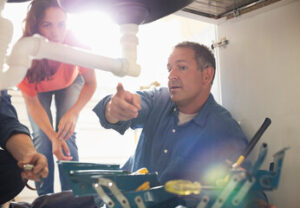Painters in Fresno CA paint surfaces of all kinds, including walls and ceilings. They also prep those same surfaces and clean up afterward. Their expertise and craftsmanship result in a flawless finish.

Before hiring a house painter, get a detailed estimate. Look for one that lists the direct and indirect costs. Also, check their licensing and insurance coverage.
A house painter’s expertise is the result of years of hands-on experience. They know how to apply a coat of paint that will last and achieve stunning results, regardless of the project size or complexity. In addition, they can provide insight into a client’s vision for their space and recommend color options that complement the home’s style and architecture. They also understand the nuances of surface preparation, paint selection and application techniques, and finishing touches that ensure a visually-stunning finish.
Professional house painters prioritize their clients’ satisfaction and deliver exceptional work that reflects their passion for the craft. They adhere to agreed-upon timelines and regularly update their clients on progress. They are also adept at handling unforeseen circumstances such as weather or wall conditions and adjusting their plans accordingly. These skills ensure that the painting process runs smoothly and seamlessly, and that clients are thrilled with the results.
Before selecting a house painter, research their credentials and customer reviews to gauge their level of professionalism. You can also ask for references from friends and neighbors to get an idea of their experience with local house painters. Once you’ve compiled a list of potential pros, request estimates from each. Then, narrow down your choices by comparing their prices and the details of each estimate.
When choosing a house painter, look for one with a diverse portfolio showcasing a range of projects and finishes. A varied portfolio is a good indicator of a house painter’s versatility and ability to handle multiple types of painting projects. In addition, check whether they have the necessary licenses to operate in your area. Licensing and insurance are essential safeguards against any mishaps or accidents that may occur during the painting process.
Time efficiency
Painting a room or an entire house can be a time-consuming project. It can take weeks or even months to finish, particularly if extensive prep work is required. It’s important to hire a professional company that offers interior and exterior house painting services to save you time and effort.
Professional painters are familiar with various painting techniques and materials, including the right paints for different surfaces. They also know how to apply paint evenly and smoothly for a consistent finish. The result is a polished look that enhances the property’s curb appeal and value.
Moreover, professional painters have the tools and equipment to get the job done quickly. They can complete interior and exterior painting jobs at a faster pace than DIYers, minimizing the impact on daily routines and business operations. This can be especially helpful for businesses and rental properties, where the speed of the painting process can significantly reduce downtime and lost income.
In addition, professional painters can save you time by handling the tedious tasks like surface preparation and cleanup. They can also help you choose the best color options, including durable and weather-resistant coatings for exteriors and low-VOC paints for improved indoor air quality. They will advise you on the latest trends, colors, and styles to create a cohesive and aesthetically pleasing result.
Before hiring a house painting company, ask them for a detailed timeline and estimated completion date. This will ensure that your home will be ready for a normal return to your daily activities, and it will give you peace of mind. It will also encourage clear communication between you and the house painters, as well as enable you to schedule milestones and check-ins for progress.
Cost-effectiveness
Painting is a cost-effective way to transform your home. However, it’s important to find a house painter who will provide you with an accurate estimate and a clear schedule. Look for a company with experience and a good reputation in the community. Check online reviews and ask for recommendations from friends and family members. Also, make sure that the contractor has a license and insurance coverage. This will ensure that you are protected in the event of property damage or injuries.
Professional house painters will use high-quality products and materials, which can add up to a substantial cost upfront. But these costs can be offset by the quality and longevity of the results, as well as fewer maintenance costs in the future.
In addition to paint, house painters will use a variety of other materials, including caulk, putty, plaster, brushes, rollers, and sprayers. These materials can be messy and require protective gear to avoid health risks. In addition, they can also emit strong odors that may be unpleasant to live with.
Moreover, they’ll know what type of paint is best for each surface-a flat finish for your formal dining room, eggshell for the high-traffic kitchen, and durable semi-gloss for trim and cabinets. They’ll also understand how color affects light and ambiance and help you select colors that complement your architectural features.
Safety compliance
Safety compliance ensures the well-being of painters and reduces the risk of accidents and injuries. This includes wearing appropriate protective equipment and following occupational health regulations. It also involves avoiding hazardous materials and handling them properly. For instance, it is essential to use a respirator in restricted areas or when using aerosol paint. It is also vital to maintain airflow in work spaces and use exhaust ducts to disperse fumes away from occupied rooms. This mitigates the danger of toxic exposure to painters and occupants.
Another important safety measure is to avoid painting in adverse weather conditions, such as rain or high winds, which can make ladders unstable and pose a hazard to occupants. It is also important to perform a comprehensive hazard assessment before the start of a project and address potential hazards. This helps to avoid costly accidents and saves time.
Working with chemicals and solvents presents many hazards to painters, including inhalation of volatile organic compounds (VOC) from solvent vapors. These fumes can lead to headaches and dizziness, as well as damage the lungs. It is therefore vital to read the safety data sheet for each chemical before using it and follow proper storage and disposal guidelines.
Moreover, a professional should be certified and trained to handle lead-based paint. This is particularly important in older buildings, where this material is commonly found. The EPA’s RRP rule requires all contractors to be certified and trained in safe practices for removing lead-based paint. Lastly, it is imperative to wear gloves when handling hazardous materials. Gloves protect the skin from irritation and prevent injury from drips, splatters, or splashes.
It is also crucial to keep a first aid kit on hand in case of any emergencies. Lastly, it is necessary to take frequent breaks while working. This will help to avoid fatigue, which can lead to a range of injuries, including repetitive strain injury (RSI).
Enhanced property value
House painters use techniques to transform spaces and elevate a property’s aesthetic appeal. Unlike DIY projects, they usually execute their work precisely to ensure a high-quality finish that will last for years. These finishing touches make a big difference in the overall appearance of a space and can add value to a home or commercial building. For example, a painted wall can enhance a room’s ambience by highlighting architectural features. It also helps buyers imagine themselves in a well-maintained and well-cared for home.
In addition to colour selection, professional painting services can enhance a property’s kerb appeal by addressing cosmetic flaws. They can hide unsightly stains, uneven textures, and obvious fissures to create a flawless finish that is attractive to potential buyers. This will help you get a better price for your home or business.
Hiring a house painter can also help you save money in the long run, since they can take care of most of the work on your behalf. However, it is important to make sure that you choose a contractor who has experience and is licensed by your local government. Make sure to read reviews and ask questions before hiring a company. You should also ask about the price, timeframe, and any other details you may need to know.
A professional paint job will raise the resale value of your property, making it more attractive to potential buyers. It will also make your home or business more appealing to investors, as it will stand out from the competition in the real estate market. Furthermore, a fresh coat of paint will make your home or commercial property more energy efficient and comfortable to live in.


